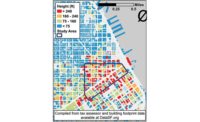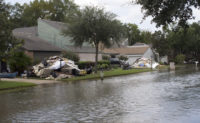“Damage included significant ductility demands in the frames in both directions, dilation, loss of vertical support and sliding shear failure of the floor diaphragms, some gravity-beam shear cracking, collapse of four sets of stairs inside the building, some de-seating of the surrounding car-parking structure and some damage in both the precast and retained facades,” says Alistair Cattanach, director of Dunning Thornton.
“Instead of demolition, a program of temporary strengthening was embarked upon to allow recovery of the tenant fit-out, and greater salvage of building materials,” he says.
The temporary strengthening involved a top-down sequence of retrofit of the floors, some of which had slipped up to 30 millimeters down the faces of the beams. This retrofit provided vertical and tying-diaphragm capacity to allow crews to move down to work on the floor below. The deconstruction allowed close examination of the damage and provides useful lessons for the detailing and retrofit of reinforced concrete frame structures.
“Through this deconstruction philosophy, over 95% of the building was able to be sorted and recycled,” Cattanach says. “The building was monitored and performed satisfactorily through aftershocks during the deconstruction process.”
Dr. Ian Aiken, principal at Seismic Isolation Inc. of California, touted base-isolation strategies during his keynote presentation. Seismic isolation began to be implemented about 35 years ago in New Zealand, Japan and the U.S. In the last few years, interest in its use has increased in Italy, Turkey, Chile and elsewhere.
“The occurrence of severe earthquakes has been a major influence on the rate of acceptance and adoption of seismic isolation, but the influence of code provisions has proven to be both a help, and in some cases somewhat of a hindrance, to adoption in different countries,” Aiken says. “Over the past ten years, cities in California and other seismically active regions of the U.S. have adopted performance-based approaches for the design of tall buildings and other special structures. Nonlinear response history (dynamic) analyses are now an essential component to evaluate whether earthquake demands satisfy specified acceptance criteria.”
While the primary motivation of these methods has been to enable the use of structural systems—such as concrete shear-wall systems—that are not otherwise permitted for tall buildings by traditional prescriptive building code provisions, the performance-based approaches offer opportunities for further innovations, he says.
“In particular, comprehensive performance-based assessments to quantify economic losses and downtime can help inform the public of expected seismic performance, and incentivize owners and other stakeholders to invest in measures to improve building performance,” he adds.








